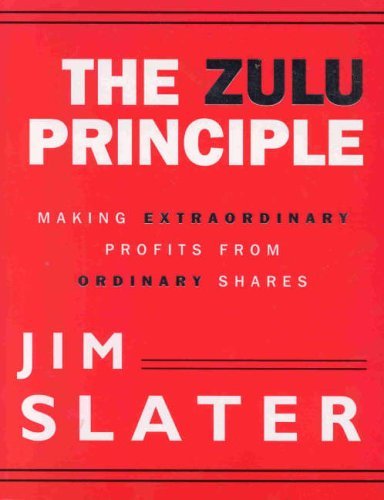Growth Investing, Jim Slater and the Zulu Principle
When Jim Slater contracted a viral illness that left him bed-ridden for weeks, in the 1960's, it changed his life. Because he had time on his hands, he devoured books and articles on investment, determined to see if there was a way to earn a living from investment should he be unable to go back to work. He eventually honed a system, and an article he wrote about it was published in the Sunday Telegraph and eventually became an investment book.
He called the book The Zulu Principle to illustrate the importance of specialisation, the key to his investment strategy – the name was triggered when his wife started to read up on Zulus and quickly became an authority on them because it was a narrow area of knowledge and crucially no one else was looking to specialise in that area. Jim Slater recommends that you specialise in a certain field or aspect of investing and concentrate your efforts. That way, you should have more knowledge and should be able to exploit share opportunities that elude the generalist.
This page discusses the main aspects of Jim Slater’s method.
The PEG factor
Jim Slater invented a metric called the PEG factor, to help him select the shares with most potential of growth.
Essentially the PEG factor is the P/E ratio (price/earnings ratio) divided by estimated growth rate in earnings per share. He is looking for shares with a PEG factor of less than 1. The P/E ratio should tell you how expensive the share is in relation to it’s existing earnings. The PEG factor brings future earnings into the equation, to enable you to see whether the share is over priced or under priced.
For example, say you have company A, with a P/E ratio of 30. In other words, it’s share price is 30 times it’s current earnings. But the company’s earnings have been growing at 20% per annum in the last five years and is estimated to continue to grow at that rate. It’s PEG factor would be 1.5 (30/20). The share price is too expensive. However company B with a P/E ratio of 10 and a growth rate in earnings of 20% per annum will have a PEG of 0.5 – it is cheap.
The real difficulty is getting to grips with the growth in earnings of the company. Slater recommends that you look at their past five years of earnings and look at the rate their earnings per share have grown year on year. Then estimate future earnings, taking into account current conditions.
The best time to buy is during recessions, because shares become depressed in value (due to a panic about the recession affecting company earnings). If you find a company who is doing well despite the recession, but their share price has been depressed, snap it up.
The other criteria Slater recommends when buying a share
Jim Slater also lists a set of criteria that he feels a share should meet before it qualifies as a good buy:
A prositive growth rate in earnings per share for at least four of the last five years
A low PEG factor
The Chairman’s statement must be optimistic
Stong liquidity, low borrowing and a high cash flow
Competitive advantage
Something new (the company has something special or unique about it)
A small market capitalisation
High relative strength compared with the rest of the shares in the sector
A dividend yield
A reasonable asset position
The management should own shares in the company
You can find some of the information such as market capitalisation in the Financial Times, for other criteria, you will have to request a copy of the company accounts (which is usually posted on the website of the company concerned), and read it through, including all the notes that explain the accounts.
The Zulu Principle book
The book expands on the criteria above. Jim Slater goes into considerable detail in showing the reader how to read company accounts, how to calculate the cashflow and liquidity and how to weigh the criteria. He also talks about creative acconting and how to spot when something is wrong with a company that looks good on the surface.
I definitely recommend people purchasing this book and reading the chapters closely, especially the ones on how to read company accounts.

This method still works. If you can't find any share that meets the criteria, it just means the market is overvalued - sit on your hands and wait for the bubble to burst.
Estimating future income is trickier than it used to be because we have so many unexpected events occuring (great financial crash, brexit and so on).
I wonder what Jim Slater has to say about bitcoin and other cryptocurrencies. How would a method like his value them?
Congratulations @alyssasanders! You have completed some achievement on Steemit and have been rewarded with new badge(s) :
Click on any badge to view your own Board of Honor on SteemitBoard.
For more information about SteemitBoard, click here
If you no longer want to receive notifications, reply to this comment with the word
STOPCongratulations @alyssasanders! You have completed some achievement on Steemit and have been rewarded with new badge(s) :
Click on any badge to view your own Board of Honor on SteemitBoard.
For more information about SteemitBoard, click here
If you no longer want to receive notifications, reply to this comment with the word
STOPCongratulations @alyssasanders! You have completed some achievement on Steemit and have been rewarded with new badge(s) :
Click on any badge to view your own Board of Honor on SteemitBoard.
For more information about SteemitBoard, click here
If you no longer want to receive notifications, reply to this comment with the word
STOP